Nanography® is the enabling science behind a breakthrough digital printing method that combines the variable-data and print-on-demand features of digital printing with the throughput speed, media versatility, and quality of offset printing.
The inks used for the process were developed with nanotechnology — the science of particles that are measured in nanometers (billionths of a meter).
Nanography was invented by visionary digital-printing pioneer Benny Landa, who discovered that water-based inks formulated with nano-sized pigment particles perform differently than standard water-based inks used in production inkjet printing.
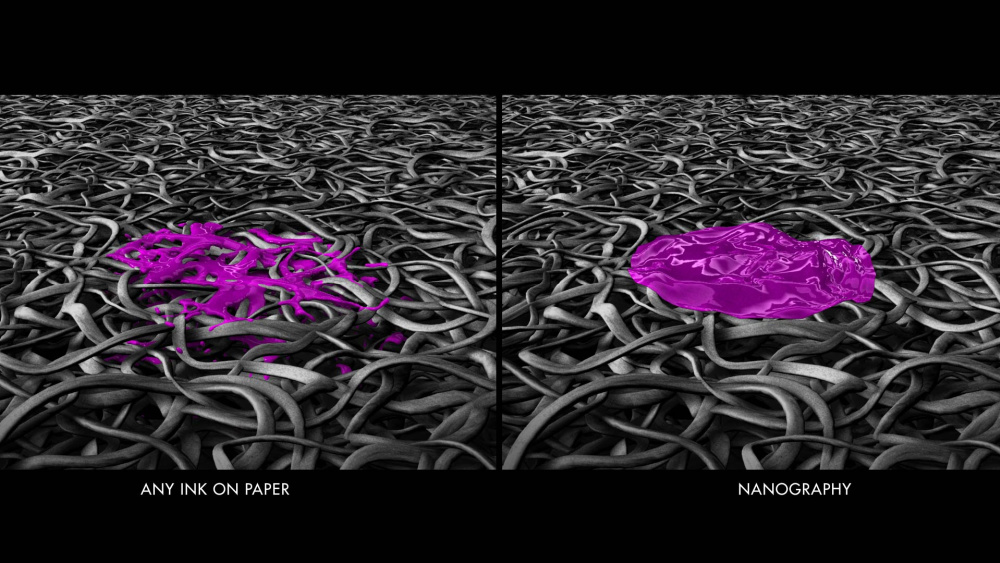
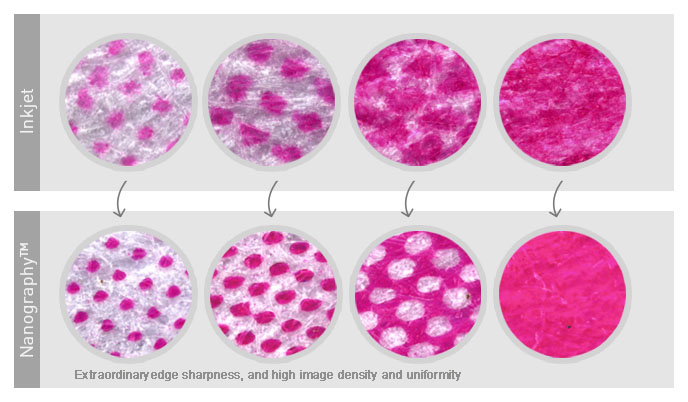
Landa Digital Printing is using the nanographic printing process to develop high-speed digital printing presses for short-to-medium run lengths for commercial printing, publishing, packaging, and direct-mail applications.
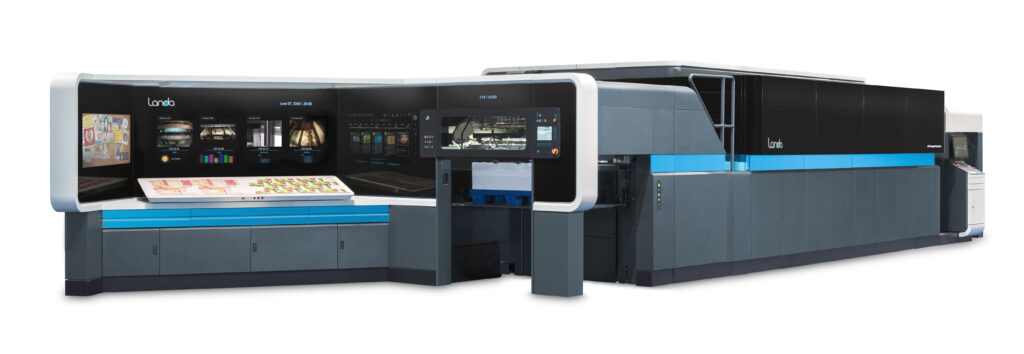
How Nanography Differs from Production Inkjet
Like a production inkjet press, nanographic printing uses high-speed inkjet printheads and sophisticated software to convert digital files into data that dictate how, when, and where each ink color droplet should be ejected to form the images.
But instead of ejecting wet inks directly onto paper, the printheads deposit the inks onto a specially constructed “blanket” which is then dried before it passes beneath rollers. Pressure from the rollers transfers the image from the blanket to the selected material.
Depending on how each press model is engineered, the Landa dry-ink transfer process will work with the standard off-the-shelf materials used to produce magazines, catalogs, direct mail, folding cartons, or flexible packaging.
In contrast, jobs on production-inkjet presses often require materials manufactured specifically to control the spread of the wet inks as the papers pass quickly beneath the printheads. These materials cost more than substrates already developed for high-volume production on traditional offset or flexographic printing presses.
Like other digital processes, nanographic printing doesn’t require the time and expense of creating and loading a new set of plates for each color on every job. So, the process is inherently more efficient than and cost-effective in producing an uninterrupted sequence of small to mid-sized jobs. Many of these these types of print jobs now include custom designs, localized or personalized messages, or QR codes.
Nanographic printing enables owners of existing offset, flexographic, and gravure presses to focus on running their highest volume jobs on their analog equipment.
Flexibility in run lengths makes it feasible for global brands and retailers to offer more specialty products and seasonal promotions. And, packages, promotions, and inserts can be customized to reflect the buying habits and languages of consumers within each city.
Seven-color Landa presses add orange, green, and blue inks to the standard 4-color inks (Cyan, Magenta, Yellow, and Black) used by color offset presses. This 7-color combination can reproduce 96 percent of the Pantone colors that brands use to differentiate themselves in their logos and marketing materials. But even the 4-color Landa (CMYK) presses can hit 84 percent of Pantone colors, 30 percent more than CMYK offset.
The ability to hit a wider gamut of colors than standard offset four-color printing means that Landa press operators don’t have stop and load custom-mixed Pantone spot colors to handle a series of jobs from different clients.
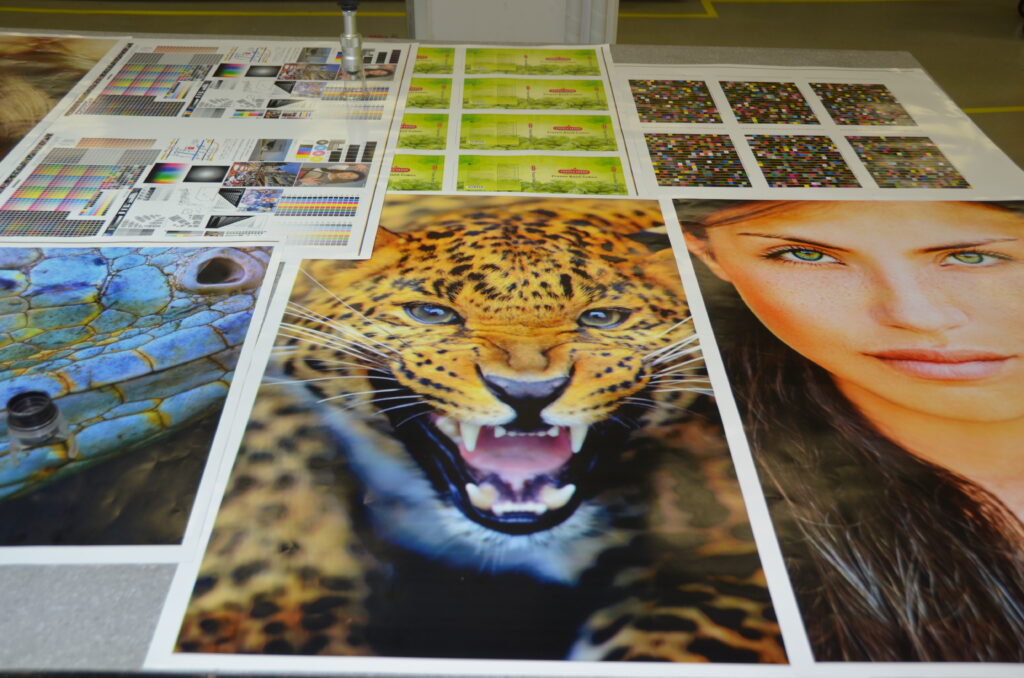
Why Nanographic Printing Is A Breakthrough
The Landa presses are designed to close the “profitability gap” between digital printing presses and the offset, flexographic, or gravure presses that used to mass produce graphics for packaging, magazines, and marketing materials.
Digital presses that use electrophotographic or inkjet technologies have improved in quality, but are still slow compared to traditional offset and flexographic presses. Plus, the costs of inks, toners, and treated or coated papers add up quickly when a customer orders more than a few thousand copies.
Because the Landa presses can print at high-speeds on the same materials that big printing companies already use, owners of offset and flexographic presses can now produce short to medium-run jobs that wouldn’t be profitable on their standard presses.
Current Models
Landa Digital Printing introduced the Nanography process at the drupa global print technology exhibition in 2012 and displayed the first press, the sheetfed S10, at drupa 2016. The first Landa press was installed in 2017. In 2019, Landa Digital Printing began installing a second model: the S10P. Here are a few details about each model.
The Landa S10 is a single-side sheetfed press for mainstream packaging applications such as folding cartons and point-of-purchase/point-of-sale graphics. The S10 prints 6,500 B1 sheets per hour on substrates in thicknesses 2.4 to 32 pts. An inline coating system can enhance or protect the printed materials with UV or aqueous coatings.
The S10 can run seven colors and be profitable on jobs of about 30,000 boxes or even higher when ganging jobs or adding variable barcodes. The S10 provides a digital production solution for more than 50% of all folding carton jobs.
The Landa S10P Nanographic Printing Press is for general commercial print jobs that require printing on both sides of the substrate. For example, the S10P can handle advertising pieces, catalogs, direct-mail, and high-end magazines.
Landa Digital Printing is currently developing web-fed presses for flexible packaging and high-end publishing.
Workflow and Quality Control
The data required to print each job is processed through a digital front end (DFE) that is tightly integrated with each press. Based on EFI Fiery technology, the Landa DFE enables to press to fit into any printing environment, regardless of what mix of digital, offset, or flexo printing processes the company uses.
The Landa DFE not only communicates with prepress automation applications and business-management software, but also with finishing equipment.
All Landa presses are equipped with an active quality management system that fully scans each printed sheets, identifies defects, and initiates corrective actions. Operator intervention isn’t required.
Comments from Users of Landa Presses
Some of the companies using Landa presses in the U.S. include:
- K-1 Packaging Group, City of Industry, CA
- Marketing Alliance Group, Dalton, GA
- Duggal Visual Solutions, New York, NY
- Virtual Packaging, Grapevine, TX
- Hudson Printing, Salt Lake City, UT
K-1 Packaging Group provides custom packaging solutions for consumer products. K-1 uses the Landa S10 for jobs use 5,000 sheets or less. The work includes folding cartons, countertop displays, labels, and litho-lam corrugated boxes.
K-1 President Mike Tsai said a key factor in the decision to buy the press was how fast the Landa press could produce back-to-back short-to-medium-run jobs. A press run that would have required eight make-readies on a conventional press were achieved in just 70 minutes on the Landa S10.
Because the Landa press handles sophisticated jobs with ease, Tsai said K-1 will be able to bring a more holistic, integrated approach to their clients. For example, K-1 can process and print a client’s 1-to-1 variable product codes, support traceability of products, and meet other supply chain requirements.
Duggal Visual Solutions is an award-winning global supplier of exceptional printed visuals, custom displays, and multi-media solutions for global retailers, Fortune 500 corporations, museums, galleries, non-profit organizations, photographers, and visual artists.
Duggal installed a 7-color S10 Nanographic Printing Press at their New York production facilities to better serve their clients, which include 16 of the top 25 brands in the Interbrand Top 100.
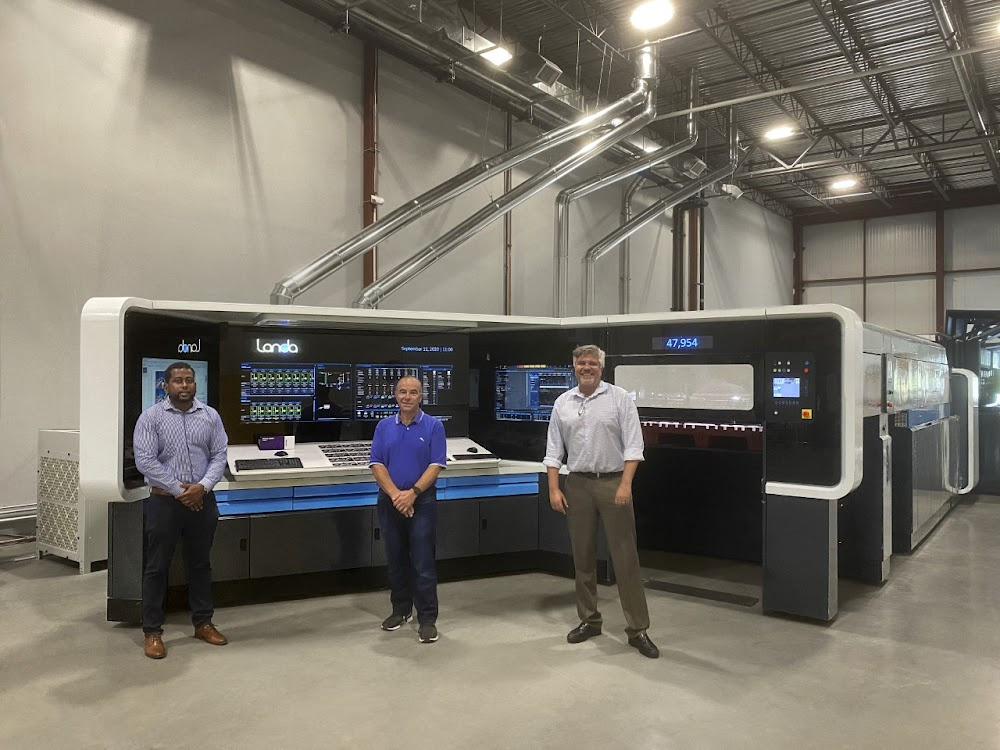
“We are blessed to work with so many of the world’s leading brands and creative minds,” said Mike Duggal, CEO of Duggal Visual Solutions. He said the Landa S10 enables Duggal to help their customers break new ground in what is possible with print.
Duggal sees nanongraphic printing technology as the logical next step in the company’s evolution from their heritage in high-end imaging for professional photographers. Since moving into high-impact corporate work, Duggal now produces a wide range of applications for in-store marketing.
The Marketing Alliance Group is one of the largest retail design and manufacturing companies in the U.S. The company makes visual merchandising displays and fixtures for grocery stores, convenience stores, and manufacturers of health and beauty, apparel, home improvement, and flooring products. Clients include some of the leading retailers and brands in North America.
The Marketing Alliance Group is using their Landa S10 Nanographic Printing Press to deliver faster, higher-quality digital printing of short-to-medium runs of retail signs and displays.
“We already had a considerable print operation with a mix of analog and digital printing capabilities, and they all have their place,” explained Bryan Hair, CEO of Marketing Alliance Group. “But the Landa S10 fills a different gap. It’s not only substantially faster than any other digital press, but it also has an offset format. Thanks to its seven colors, the color vibrancy and high print quality satisfy our world-leading brand customers, too.”
Hair said the S10 enables enables retail customers to reduce costs, stock, and waste while getting promotions into stores much faster. “We consider Nanography to be the new era in printing technology.”
Virtual Packaging is an all-digital company founded in 1996. They provide full-service production of packaging prototypes and folding cartons to a variety of U.S. and international brands. The company can provide everything from a single mock-up for a presentation to a few thousand prototypes for market testing.
During a WhatTheyThink! webinar, Virtual Packaging Vice President Jordan Patterson said the Landa S10 press complements their existing fleet of digital printers. Over the past 2 years, the Landa has enabled them to expand their revenue streams to include sustainable packaging and corrugated boxes. The have also used the Landa to print 8,000 posters with different quantities of 127 poster designs. Making plates required to run such a job on an offset press would have been extremely costly.
One of the biggest jobs VIrtual Packaging has handled on the Landa involved printing 100,000 variable-data sheets on a plastic packaging substrate. Problems with ink adhesion made it difficult to print the job with offset and/or Indigo presses. Virtual Packaging completed the job on the Landa in two days.
Virtual Packaging also serves trade printing companies and smaller start-up brands. For example, if a company sells only 6,000 products per month, the client can order folding cartons on a subscription basis. Instead of printing 72,000 cartons for a year’s supply of cartons, the client receives just the number of packages they need each month. The client doesn’t have to warehouse boxes and the brand manager to ttweak the package design each month. One Virtual Packaging client that orders packaging on a subscription basis advertises a related product on an interior panel of the carton and includes a different coupon code each month.
About the Inventor
The Nanographic Printing® process was invented by Benny Landa, the same visionary who created the Indigo liquid electrographic digital printing process for the high-speed production of high-quality color images.
Landa established the Indigo company In 1977 and sold it Hewlett-Packard in 2002. Then, he immersed himself in studying ways nanotechnology could be used to save the planet.
Today, Benny Landa holds more than 800 patents worldwide. He is the Chairman and CEO of the Landa Group in Rehovot, Israel. The Landa Group includes Landa Digital Printing, Landa Labs, Landa Ventures, Lusix, and the Landa Fund.
Read more about Benny Landa’s background and achievements by visiting: Benny Landa – Landa Nanography
For More Information
On the Landa website (landanano.com), you will find more details about each Landa press. You can also download white papers such as this one:
Nanographic Printing® – Landa Nanography describes the printing process in more detail and how Nanography has evolved.
